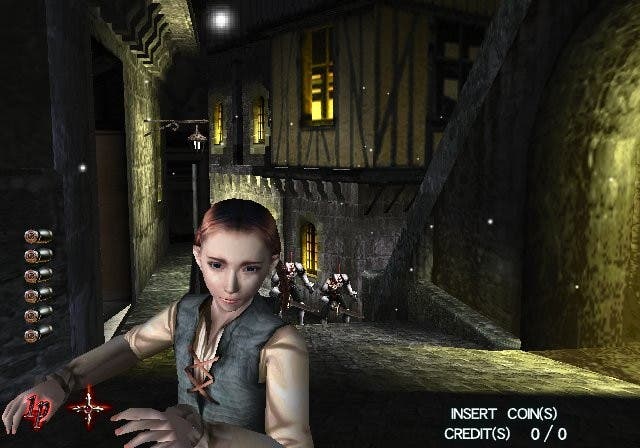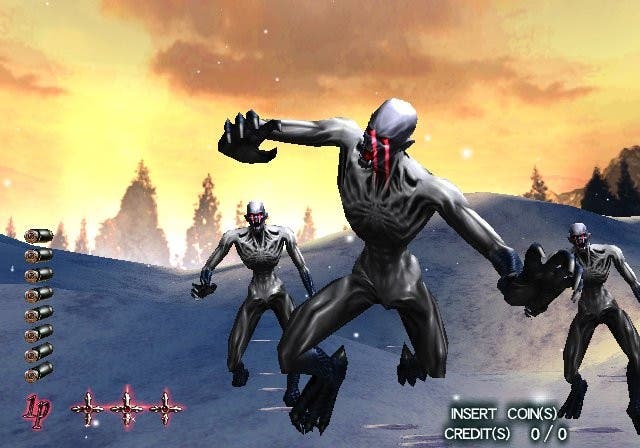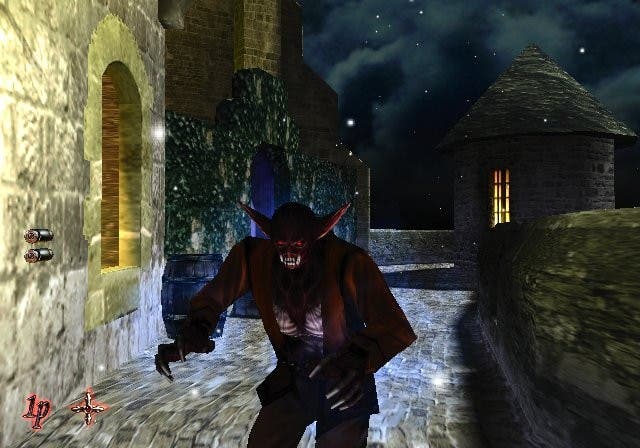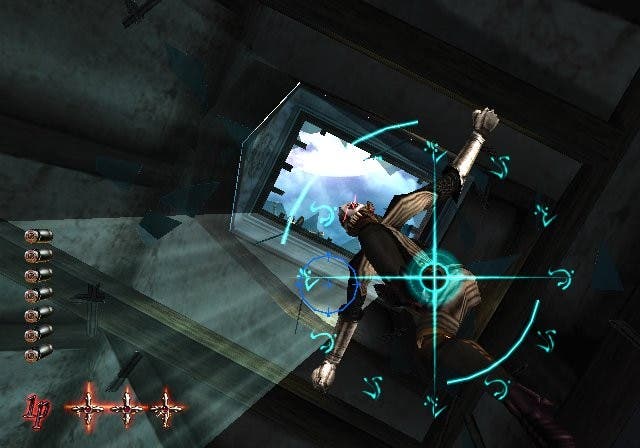Vampire Night
Review - will you still be clutching those light guns at dawn?

Night of the Living Boredom
Sega and Namco, working together on a game. What excitement can we expect to venture forth from this vast, collective imagination? Innovative gameplay, a detailed story, likeable characters, beautiful visuals, a memorable soundtrack? How about none of the above? Apparently somebody threw a light gun amongst the two teams and they vomited forth this abomination. Welcome to Vampire Night, an exercise in slap-dash game composition.
It's a good thing Vampire Night is a light gun game, because somebody needed shooting. This disappointing blaster is a typical gun-toting affair with a single player mode that's over in an hour, a special mode boasting foibles which add practically nothing to the formula, and a repetitive, overly elaborate training mode which actually spoils most of the game.
The story is pretty standard, cooked up on the first afternoon of the game's development I'd wager, and sees the player taking on the role of Vampire Hunter (with optionally playable sidekick) on a quest to rid a nameless village and the haunting, Dracula-esque castle overhanging it of their demonic inhabitants. The added twist being that the Vampire Hunters may cease to exist if they vanquish all the vamps. There's also an annoying little girl who springs up at the beginning of the game and tags along - causing trouble for everybody - and binding together what little plot there is, yelling things like "why can't you settle your differences?" as two blood-soaked Hunters take on a bizarre amphibious lizard death monster vampire thing. You can't shoot the little girl though. And believe me, we tried.

Shooting Gallery
The idea is to go around blasting enemies until their little green health bars have depleted. There is no Time Crisis 2-style ducking and diving gimmick involved here, but there is at least a reasonable amount of variety in the enemies you face. At first you come up against simple 'runners', who leap out of nowhere and slice you unless you can blast them in time, and before long their ranks swell to include possessed knights, flying demons, weird cackling magicians that hide in the floor and throw blobs of black oddness at you upon emerging, and enemies with flamethrowers and huge gas tanks on their back for you to target, along with five boss characters.
Unfortunately, there are also some truly awful enemies who pop up with infuriating regularity. Take, for instance, the little goblin bastards who race around your feet and hurl what looks like paint at your face, or the circular-tunnel-dwelling metallic demons who spin around in little balls making them almost impossible to mash. Perhaps most annoying of all though are the balls of lava thrown into your path by the second boss character, whose gender we have yet to establish thanks to the peculiar voice acting and ambiguous character model. These bounce up and down, on and off the screen, and fly at you from different angles. All must be destroyed, with precision.
There are also sections demanding the player to shoot little octopus look-a-like blobs attached to infected humans. Hitting these blobs will release infected parties from their unfortunate curse and tot up a fair amount of points at the end of the mission, but failure to do so, even by a hair's breadth, will mean the victim's conversion into a werewolf and a lightning fast attack to shield yourself from.

It's English, Jim, but not as we know it
Graphically, Vampire Night is House of the Dead 2 done differently, although not too differently - the loading screens are almost identical. First of all you dart around a snowy graveyard shooting the recently undead, before skating across some glassy, unrippling water and meeting uninspiring enemies and peasants under the grip of the werewolf blobs. Levels consist almost entirely of big gothic castle interiors and exteriors from there on in, although the fourth "chapter" of the game (if this is a book, then it rivals Spot The Dog) is a nice diversion through an icy world as you take on the weird vampire Queen.
Other highlights, if that's an appropriate term, include the pursuit of the gender-confused vamp we mentioned earlier across broken bridges and through enormous towers, and being pursued by the game's first boss (arguably the best), blurring in and out of sight as you race through the darkened forest towards the castle and a fight with his alter-ego, a minotaur wannabe with ferocious horns.
Graphical detail is quite nice, with destructible suits of armour, barrels and the like slightly more concealed than usual, but it's still pretty repetitive in design. And since we're back on the dark side of the game, we might as well deal with the script and dialogue. The words "utterly diabolical" come to mind. Because their light gun games are over in a flash, both Sega and Namco seem to have taken to localising them for the US and European markets whilst still in Japan, so the voices all sound like Stephen Hawking meets Stereotypical Japanese Gentleman, with comical emphasis on all the wrong words - and that's before we get to the script, which is about as convincing as Harold Shipman's defence lawyer.

So what's the point?
The idea, as with Time Crisis 2, is to encourage replay in pursuit of higher scores, and there's a bit of deviation in routes through the game scattered about (often hinging on defeating a particular enemy before he does something). Ultimately though the repetitive uninspired gameplay, linearity and atrocious production values condemn Vampire Night to a grave fate (and score). Shooting things on the television is obviously fun for a while, but the sheer number of rounds to pop off is quite enormous and the experience wears you out quite quickly. Of course, then you figure out 'the trick'. Instead of pointing the gun off-screen to reload, clutch either the B button located on the barrel of the gun or the one on the butt (originally used to duck in and out of scenery in Time Crisis) and you can reload without moving the crosshair from your target - welcome to fully automatic weaponry with unlimited ammo.
Of course, there's more than just a calibration screen and modes for two players on offer. Technically. Special mode is the same as the vanilla arcade mode, but you earn pieces of silver and other special items as you go along with which to purchase more powerful weapons and accessories. But even if you take on both Arcade and Special modes, you'll still only lose a couple of hours of your life.
Training mode completes the so-called package, inviting you to practice various skills to three depths of difficulty, but these gravitate between the insultingly simplistic and the ludicrously tough, so it's not much fun. Admittedly, you could spend a couple of hours here, repeatedly shooting enemies and targets and replaying the boss battles over and over on different difficulty levels, but there isn't much point, and the hardest task of all is a level full of those annoying werewolf-spawning octopi, simply because it requires you to shoot them precisely. Light guns, not to mention humans, don't always do that, and having to do it over and over again is not fun.
Conclusion
Vampire Night is a good enough way to wile away a rainy Sunday afternoon, and as such it's the perfect rental, but as a full-priced videogame it's laughable - £15 would be more reasonable than £35. The developers vary the pace here and there, injecting some diversionary tactics into proceedings, but after a while you get completely sick of the whole affair. The most criminal thing about Vampire Night though is that it's a terrible waste of a dreamy developmental crossover. We suggest you buy Time Crisis 2 instead, and don't line the pockets of the people responsible for this...

